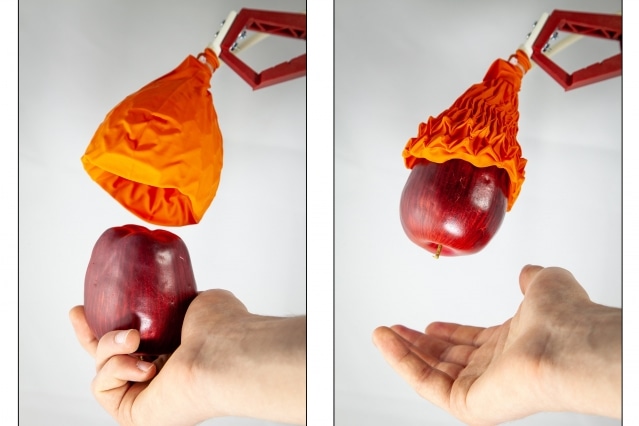Mar 18 2019
Five decades ago, the first industrial robot arm (called Unimate) assembled a basic breakfast of coffee, toast, and champagne. While it might have appeared like a seamless achievement, every movement and placement was coded with meticulous consideration.
 The origami gripper can lift a wide range of objects, from apples and soup cans to wine glasses and drones. (Image credit: Jason Dorfman/MIT CSAIL)
The origami gripper can lift a wide range of objects, from apples and soup cans to wine glasses and drones. (Image credit: Jason Dorfman/MIT CSAIL)
Even with the present-day’s more intelligent and adaptive robots, this task remains tough for machines with stiff hands. They tend to function only in structured settings with predefined locations and shapes, and generally cannot cope with doubts in form or placement.
In the last few years, though, roboticists have found ways to deal with this issue by creating fingers out of soft, flexible materials such as rubber. This flexibility allows these soft robots to pick up anything from boxes to grapes and empty water bottles, but they are still incapable of handling heavy or large items.
To offer these soft robots a little help, scientists from MIT and Harvard University have created a new gripper that is both strong and soft: a cone-shaped origami assembly that collapses in on objects, quite like a Venus’ flytrap, to pick up items that are nearly 100 times its weight. This motion allows the gripper to grasp a much wider variety of objects—such as hammers, soup cans, drones, wine glasses, and even a single broccoli floret.
“One of my moonshots is to create a robot that can automatically pack groceries for you,” says MIT Professor Daniela Rus, director of MIT’s Computer Science and Artificial Intelligence Laboratory (CSAIL) and one of the senior authors of a new paper describing the project.
Previous approaches to the packing problem could only handle very limited classes of objects—objects that are very light, or objects that conform to shapes such as boxes and cylinders—but with the Magic Ball gripper system we’ve shown that we can do pick-and-place tasks for a large variety of items ranging from wine bottles to broccoli, grapes and eggs. In other words, objects that are heavy and objects that are light. Objects that are delicate, or sturdy, or that have regular or free-form shapes.
Daniela Rus, Professor and Director of CSAIL, MIT
The project is one of several in the last few years that has scientists visualizing outside the box with robot design. Ball-shaped grippers, for instance, can cope with a wider variety of objects than fingers, but still have the problem of limited angles. Softer robotic fingers normally use compressed air, but are not adequately strong to pick up heavier objects.
This new gripper’s structure, in the meantime, takes a completely different form. Cone-shaped, hollow, and vacuum-powered, the device was enthused by the “origami magic ball” and can enclose a full object and successfully pick it up.
The gripper comprises of three parts: the origami-based skeleton structure, the airtight skin to enclose the structure, and the connector. The team made it using a mechanical rubber mold and a special heat-shrinking plastic that self-folds when exposed to high temperatures.
The magic ball’s skeleton is covered by either a thin fabric sheet or a rubber balloon, not different from the team’s earlier study on fluid-driven origami-inspired artificial muscles, which comprised of an airtight skin surrounding a foldable skeleton and fluid.
The team employed the gripper with a typical robot to test its strength on various objects. The gripper could grip and lift objects 70% of its diameter, which enabled it to pick up and hold a range of soft foods without damaging it. It could also pick up bottles that weighed more than four pounds.
“Companies like Amazon and JD want to be able to pick up a wider array of delicate or irregular-shaped objects, but can’t with finger-based and suction-cup grippers,” says Shuguang Li, a joint postdoc at CSAIL and Harvard’s John A. Paulson School of Engineering and Applied Sciences. “Suction cups can’t pick up anything with holes—and they’d need something much stronger than a soft-finger-based gripper.”
The robot, at present, functions best with cylindrical objects such as cans or bottles, which could one day make it an asset for manufacturing lines in factories. Not unexpectedly, the shape of the gripper makes it harder for it to grip something flat, like a book or a sandwich.
“One of the key features of this approach to manipulator construction is its simplicity,” says Robert Wood, co-author and professor at Harvard’s School of Engineering and Wyss Institute for Biologically Inspired Engineering. “The materials and fabrication strategies used allow us to rapidly prototype new grippers, customized to object or environment as needed.”
Going forward, the team expects to try to solve the issue of angle and orientation by including computer vision that would allow the gripper “see”, and make it feasible to hold particular parts of objects.
“This is a very clever device that uses the power of 3D printing, a vacuum, and soft robotics to approach the problem of grasping in a whole new way,” says Michael Wehner, an assistant professor of robotics at the University of California at Santa Cruz, who was not involved in the project. “In the coming years, I could imagine seeing soft robots gentle and dexterous enough to pick a rose, yet strong enough to safely lift a hospital patient.”
The paper’s other co-authors include MIT undergraduates John Stampfli, Helen Xu, Elian Malkin, and Harvard Research Experiences for Undergraduates student Evelin Villegas Diaz from St. Mary's University. The researchers will present their paper at the International Conference on Robotics and Automation in Montreal, Canada, in the coming month of May.
This project was aided partly by the Defense Advanced Research Projects Agency, the National Science Foundation, and Harvard’s Wyss Institute.
Origami Robot Gripper